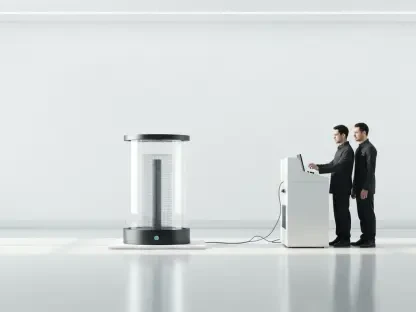Imagine slipping on a pair of headphones that not only stream your favorite playlist but also delve into the intricate workings of your mind, alerting you when focus wanes or mental fatigue sets in, promising a new frontier in personal wellness. This is the bold vision behind brain wearables, an innovative class of technology that seeks to transform the landscape of fitness and wellness by monitoring brain activity through electroencephalography (EEG) sensors. Unlike conventional fitness trackers that tally steps or measure heart rate, these devices aim to unlock a deeper layer of personal health data, offering insights into cognitive states like stress, concentration, and mental endurance. The potential to bridge the gap between physical and mental performance has sparked excitement among tech enthusiasts and wellness advocates alike. However, as this technology emerges from the realm of science fiction into consumer markets, significant doubts persist. Can brain wearables truly deliver on their ambitious promises to revolutionize how mental well-being is tracked, or are they merely a trendy novelty with more hype than substance? This exploration dives into the allure, the scientific grounding, the ethical dilemmas, and the market readiness of this cutting-edge tech, aiming to separate fact from fiction in a rapidly evolving field.
Unveiling the Potential of Cognitive Tracking
Brain wearables, such as Neurable’s MW75 Neuro headphones, are marketed as a groundbreaking advancement in the realm of personal health technology. By integrating EEG sensors into everyday accessories like headphones, these devices claim to capture brainwave patterns and translate them into meaningful feedback about mental states. Whether it’s detecting a lapse in concentration during a work session or signaling mental exhaustion after a grueling workout, the technology promises to provide users with real-time data to optimize both productivity and well-being. The appeal lies in the possibility of peering into the often-elusive workings of the mind, offering a so-called cognitive snapshot that could guide decisions about when to push harder or take a much-needed break. For those invested in self-improvement, this represents a tantalizing frontier, merging mental health monitoring with the physical metrics that traditional wearables already track so well. The notion of achieving a holistic view of health—body and mind intertwined—fuels optimism that brain wearables could redefine personal wellness in profound ways.
Yet, the excitement surrounding this technology must be tempered with a critical eye toward its current capabilities and long-term implications. While the concept of monitoring brain activity for fitness and wellness purposes is undeniably innovative, the practical execution raises questions about whether the market is ready for such a leap. The idea of a device that can interpret complex neural signals in a user-friendly way is compelling, but it also hinges on the assumption that consumers are willing to embrace a level of data intimacy far beyond what heart rate or step counters demand. Beyond the allure of novelty, there’s a need to assess whether these tools can integrate seamlessly into daily routines without feeling intrusive or overwhelming. As brain wearables position themselves as the next step in the quantified-self movement, their success will depend not just on technological prowess but also on striking a balance between insight and accessibility for a broad audience.
Scrutinizing the Scientific Foundation
Despite the captivating promises, the scientific underpinnings of brain wearables reveal significant challenges that temper enthusiasm. Experts in neuroscience acknowledge that EEG technology has a well-established role in clinical environments, where it’s used to diagnose conditions like epilepsy or monitor brain activity under controlled conditions. However, translating this precision to consumer-grade devices is fraught with obstacles. The sensitivity of EEG sensors to electrode placement means that improper use by untrained individuals can skew results, leading to data that’s more noise than signal. Additionally, the limited number of sensors in wearable formats, such as headphones, pales in comparison to the arrays used in medical settings, further compromising accuracy. This raises a fundamental concern: without professional oversight, the insights provided by brain wearables may lack the reliability needed to inform meaningful decisions about mental or physical health, casting doubt on their utility in everyday fitness tracking.
Moreover, the challenge of interpreting brainwave data into actionable feedback adds another layer of complexity to the debate. Many brain wearables generate metrics like “focus scores” or “cognitive load” indicators, but the science behind translating raw neural activity into such simplified outputs remains underdeveloped. Critics argue that these metrics often oversimplify the intricacies of brain function, potentially misleading users about their mental state. Compounded by steep price points—often in the hundreds of dollars—these devices risk being perceived as expensive toys rather than credible health tools. While the foundation of EEG technology is sound, its application in consumer products for fitness purposes appears to be a step ahead of current scientific validation, leaving many to question whether the leap into cognitive tracking is premature at this stage of development.
Navigating the Privacy Quagmire
One of the most pressing concerns surrounding brain wearables is the profound implication for personal privacy. Brainwave data represents an unprecedented level of biometric information, offering a window into an individual’s most intimate mental processes. Unlike physical metrics like heart rate, which are already sensitive, neural data could reveal patterns of thought, emotional states, or even vulnerabilities that users might not fully comprehend when they sign up for such devices. In the absence of robust federal regulations in the United States to govern the collection, storage, and use of this type of information, the risks of misuse or unauthorized access loom large. A data breach involving brainwave information could have far-reaching consequences, yet the legal framework to protect consumers remains woefully inadequate, leaving many to ponder the true cost of embracing this technology.
Equally troubling is the potential for constant surveillance that brain wearables introduce into daily life. Even without malicious intent, the idea of a device continuously monitoring mental activity can feel invasive to those who prioritize autonomy over technological convenience. Technology attorneys have highlighted that without clear cybersecurity standards, companies producing brain wearables may not be held accountable for how they handle such sensitive data, whether it’s sold to third parties or inadequately secured against hackers. This regulatory void not only undermines trust in the technology but also poses a significant barrier to widespread adoption. For every potential benefit that brain wearables offer in terms of mental health insights, the specter of privacy erosion casts a long shadow, prompting a critical examination of whether the trade-off is worth the risk for most consumers.
Assessing Market Readiness and Appeal
When it comes to consumer uptake, brain wearables face an uphill battle in proving their worth to a broad audience. Priced at levels that can reach $499 for models like the MW75 Neuro, these devices are far from affordable for the average fitness tracker user who might already balk at spending over $100 on a standard wearable. The high cost, coupled with unproven value in delivering reliable cognitive insights, positions brain wearables as a niche product likely to attract only a small segment of tech-savvy individuals obsessed with self-optimization. For the general public, who often seek straightforward metrics like steps taken or calories burned, the complexity and invasiveness of brain monitoring may feel like an unnecessary overreach, especially when traditional devices already meet most fitness tracking needs effectively.
Furthermore, skepticism about the practical benefits of brain wearables adds to the challenge of market penetration. Many potential users question whether the data provided offers tangible improvements to their daily routines or fitness goals, especially when the science behind the technology remains under scrutiny. The perception of these devices as experimental or gimmicky rather than essential tools for wellness could limit their appeal to early adopters and enthusiasts, rather than the mainstream fitness community. Until brain wearables can demonstrate clear, validated benefits that justify both their cost and the personal data they collect, their role in the fitness landscape is likely to remain marginal. This suggests a future where they might complement rather than replace conventional trackers, appealing to a specialized audience rather than transforming the industry at large.
Reflecting on the Path Forward
Looking back, the journey of brain wearables into the fitness and wellness arena reveals a technology brimming with potential yet hindered by significant shortcomings. The promise of decoding mental states through EEG sensors captivates imaginations, but the reality of unreliable data, privacy vulnerabilities, and limited consumer appeal paints a picture of a field not yet ready for the mainstream. Discussions among experts underscore a cautious skepticism, highlighting that while the concept is innovative, its execution falls short of the transformative impact many had hoped for at the outset.
Moving ahead, the evolution of brain wearables hinges on addressing these critical gaps with urgency. Advancements in sensor accuracy and data interpretation must take precedence to ensure the technology delivers meaningful insights rather than vague metrics. Simultaneously, robust regulatory frameworks need to be established to safeguard neural data, rebuilding trust among wary consumers. For those intrigued by the intersection of mind and technology, staying informed about scientific progress and advocating for stronger privacy protections will be key steps. As the industry navigates these challenges, brain wearables could yet carve out a valuable niche in personal health, provided they evolve beyond novelty to become reliable, secure tools for enhancing both mental and physical well-being.









